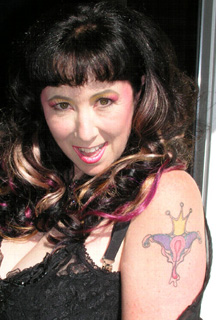|
About a month ago a friend introduced me, in passing, to the woman with whom she shares studio space. My friend whispered as we walked away, "People like Marit Victoria's work, but no one knows what to say about it."
Sometimes the perfect words exist. But they've been misused for so long they no longer jump out at us with the uniqueness they should convey. When I saw the headline Titillating Drawings, in reference to Marit Victoria Wulff Andreassen's fifth solo exhibition, I thought oh, no, that's all wrong. But it's not wrong, it's perfect. And it's not what you think.
The exhibition is titled Looking for My Mother's Tongue. Marit Victoria's works have names like Pocket-Cunt and Christmas Cock Wreath.  One of the drawings, Menstruation Medallion, is of a menstruating uterus sporting a gold crown. There are mandala-like images, the soothing aesthetics rubbing rawly against the subject matter of the delicate lines. Anuses, penises, vaginas, and pubic hair turn up in unexpected places, in unexpected sizes and quantities. When prostitute-turned-performance artist Annie Sprinkle (www.anniesprinkle.org) visited Bergen in 2003 she was introduced to Marit Victoria's work and asked permission to have Menstruation Medallion tattooed on her arm. One of the drawings, Menstruation Medallion, is of a menstruating uterus sporting a gold crown. There are mandala-like images, the soothing aesthetics rubbing rawly against the subject matter of the delicate lines. Anuses, penises, vaginas, and pubic hair turn up in unexpected places, in unexpected sizes and quantities. When prostitute-turned-performance artist Annie Sprinkle (www.anniesprinkle.org) visited Bergen in 2003 she was introduced to Marit Victoria's work and asked permission to have Menstruation Medallion tattooed on her arm.
And it's still not what you think.
"I don't create erotica," Marit Victoria says. "The significance of sex is overestimated by our society. And it's also underestimated in a way… The media gives us instructions about how to be sexy, but it's an impersonal kind of sexy." Marit Victoria is exploring the meaning and the seriousness of sex. Sex as it functions in defining identity. "Sex as an all-encompassing sensation."
Make no mistake: her artwork isn't porn, though she does occasionally receive earnest suggestions from casual viewers, suggestions for small changes that would enhance that aspect. Oddly enough, the people who make these suggestions, these people who definitely don't *get* her work, are probably the few who know exactly where that line is, the line we're all trying to pin down—the one they're trying to push her over.
In her small studio Marit Victoria reaches over and pulls an old book off the shelf. "I found this at a used books store. I had a similar one when I was little." She opens the book to show me the illustrations: the first leaf is a human body, front and back and naked. The second leaf, the same body, front and back and flayed. The muscles of the face, the torso, the legs drawn carefully to show the striated fibers of the tissue. The next leaf shows the organs. "This kind of thing fascinated me."
Marit Victoria grew up in a tiny village in Northern Norway. In fact, as the eldest child,  she was expected to take over the family farm. "We were a close family and there was very little private space. We never talked about sex." she was expected to take over the family farm. "We were a close family and there was very little private space. We never talked about sex."
On a farm? I think about my great uncle who shocked me by explaining at the breakfast table how he castrated bulls—even miming his actions so I could get a vivid picture in my mind. Surely sex was talked about.
"Yes, the animal's sex lives were a common topic of conversation, but my family never talked about their own bodies unless we were ill. When I began developing I had no idea what was happening. I knew I'd develop breasts, but I thought the hard, painful lumps on my chest were cancerous. The world's first 10 year-old breast cancer victim."
She shows me Menstruation Medallion: "I thought women should get a kind of badge for menstruating."
Like an Eagle Scout badge?
"Something like that."
Who would have guessed that the artist who drew Swat was the kind of girl who chose to study home economics in secondary school?
During high school Marit Victoria worked as a nurse's aid at a home for the mentally impaired. It desensitized her to a few sexual taboos: "If a man walked into a room right now and opened his pants and began to masturbate, I wouldn't have any problem going on with the conversation."
I believe it. And she doesn't strike me as the kind of woman who would will herself through the moment only to turn and retch in the hallway when no one was looking. Marit Victoria seems to possess a genuine grace when it comes to natural behaviour. That may be why she doesn't feel the need to create an antisocial persona to express herself.
But if her time as a nurse's aid freed her of taboos, it didn't dampen her curiosity. "This is my investigation project," she says of her art.
When Marit Victoria moved to Bergen to study at the Art Academy, she found it difficult at first. "There really weren't any role models to begin with."
"In the beginning, I thought I should paint—I thought all serious artists painted." But the instructors didn't know quite what to make of her work and they steered her toward the familiar: performance. It was as though women were doomed to address sexual themes, provocatively, only within a particular framework. This kind of thing was tried and true (and well over twenty years in the mainstream), so she tried it.
Marit Victoria opens a book of photos: the artist in lingerie, smearing butter over her body. She tells me about an installation she made with her own used tampons. After some experimentation she concluded that kind of thing was "too private. There's no room for the viewer to bring his or her own experiences to the work." Marit Victoria went back to drawing.
Then a new instructor began teaching at the Academy. A woman who understood what Marit Victoria was doing. It was the first time anyone seemed to understand the content of her work, not just the craftsmanship.
I ask Marit Victoria who her role models are now—other artists who are working with the same kind of themes?
She thinks. "Bjarne Melgaard… Well, there is Sally Mann" (the controversial photographer: http://www.art-forum.org/z_Mann/gallery.htm). Marit Victoria says that she's been discussing Sally Mann with an English colleague and was quite surprised to learn that anyone found Mann's photographs offensive.
Sexuality should fit into the bins we've made for it.
"But what choices do we have," she asks. "Choose porn or erotica?"
I point to the drawing First Meeting, a young girl observing her own erection, the tenting of the fabric of her dress. We can't see the girl's face. I try to explain my reaction to the artwork.
"Well, I've never been confused about my sexuality, I've always been aware and happy that I am female, but when I look at that…"
I finish and Marit Victoria smiles. Yes, in part, because I have described how the drawing elicits a physical, phantom response that makes me re-experience the pubescent icky-yummy tingling of sexual awakening, but mainly because we've both noticed how I've prefaced my remark.
We protect ourselves without knowing why or from what. (Or is it just me?)
When I ask Marit Victoria what her family thinks of her work, she says they are very supportive. Except perhaps the aunt who but asked why she chooses to draw ugly things so beautifully, "That's not something nice girls do."
Her father says of her work, "She just draws what other people think."
"Every interviewer asks me what my boyfriend thinks of my art. No one asks male artists that kind of question. No one asks Bjarne Melgaard what his partner thinks."
It's my turn to smile. Don't you think the interviewers are trying to determine your sexual orientation without having to ask?
"Definitely."
In Bergen Marit Victoria struggled to get funding, but things have taken a turn for the better. "Someone has to be the first to say, 'It's good'." In 2002 one of her works was purchased by the National Gallery. She's also received a grant to study in New York this summer.
When it comes to inspiration for her work, Marit Victoria says she lets "the child be curious."
Craftsmanship is crucial to her work: "It has to be so flawless that no one can dismiss it, no matter how uncomfortable they are with the subject."
It's not erotica. "I guess I do want to titillate—but titillate the thought process." She wants us to expand the framework of our categorizations. "It's not necessarily about sex as *sex*, but sex as psychology, dreams, wishes: identity."
Instead of titillating sexually by bypassing the intellect and appealing to the reptile brain, Marit Victoria's work seems to titillate physically because it stimulates the mental processes—it reawakens the pubescent being. The sexuality called upon is nostalgic. Not na´ve, but uncorrupted—physical sensations are disturbing precisely because they are new, unexpected, uncategorized, and pleasurable.
The most valuable advice I ever got about writing poetry was to present the mystery without making anything mysterious. Marit Victoria Wulff Andreassen seems to have known that instinctively.
|